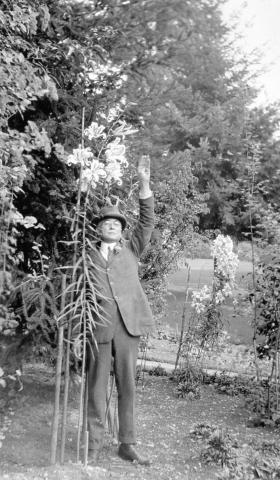It has Always Been Thus
This is the time of year passionate gardeners open their yards and show off their handiwork to the curious public as part of a garden tour.
This is the time of year passionate gardeners open their yards and show off their handiwork to the curious public as part of a garden tour. The gardens are prepared,
‘Sunday-best fashion, for the onslaught of visitors.
 They look complete, tidy, adorned with lush plantings, and love. Some have lichen-covered gates and a trellis with a gnarled vine, testimony to the length of time the lot has been tended. Others have fresh pillows on the garden seats, a dusted off art piece, and tiled steps. Their owners beam with delight when you, the visitor, express your admiration. The next step in this social dance is entirely predictable. The owners cheerfully begin discussing their plantings and layout, likely for the eight hundredth time th
They look complete, tidy, adorned with lush plantings, and love. Some have lichen-covered gates and a trellis with a gnarled vine, testimony to the length of time the lot has been tended. Others have fresh pillows on the garden seats, a dusted off art piece, and tiled steps. Their owners beam with delight when you, the visitor, express your admiration. The next step in this social dance is entirely predictable. The owners cheerfully begin discussing their plantings and layout, likely for the eight hundredth time th
at day, and usually unasked. Nothing short of passion personified! The gardening gene in full display.
It is tempting to believe when you step into tended glory that lush gardens arrive complete, ordered from Amazon.com and delivered by a truck. But gardeners know this as a fantasy, particularly the gardeners on any Open Gardens Tour. Behind that loveliness has been a power of thought and, even more, hard work. It has always been thus.
A root around the archives revealed that the Dunn Gardens were also subject to more than a little work to get them started. Interestingly, they nearly didn’t get going at all. I
n correspondence between the firm of the Olmsted Brothers in Brookline, Massachusetts, May 17, 1915, Arthur G. Dunn, wrote that he had no settled plans for the improvement of his recently acquired land. After deciding to erect a ‘cheap summer cottage’ upon it he changed his mind. In June 1 he forwarded the plans of the cottage to expedite the planning, along with a little urging that he was ‘desirous of fixing up the grounds as soon as possible.’ The signs were, even then, apparent. The gardening bug was upon Arthur Dunn. It would not be long before he would be at the stage of cheerful discussion of plantings and layout. Likely unasked. Impossible to stop.
The Olmsted Brothers replied that the property should be planned ‘to give you what you desire’ and inquired if this included a chicken house. June and July were given over to discussion via letters of many matters. The chicken house was dispensed with under instruction from Mr. Dunn in a letter sent July 12, but the location of the house and driveway was fully settled then.
What followed this discussion were the planting plans delivered by the Olmsted Brothers, complete with excitement about what they portended. Mention was made about deciduous trees along the driveway within the stands of salal. Crab apples, it was suggested, should be scattered through the existing growth on the south border to keep the natural look.
Mr. Dunn was less enthusiastic in his response. He said he ‘had hoped the plans would have been sent earlier than they had’ and now was not about to rush the plantings on account of the dubious water supply. He also said that he ‘was more in hopes that you might advise the planting of more deciduous trees.’ Then he consoled himself with ‘doubtless I can find space enough on the place for all that I will care to attend to.’ In print were the notable and universal concerns of all gardeners. Gloriously comforting for the modern one.
So what unites all gardeners is their willingness to endure all that it takes to get a garden together. And then to spend the time building and tending it. Mr. Arthur Dunn was the proudest of gardeners, taking immense pleasure in his plantings. The photo is of him preening under his lilies. If you have the garden gene you cannot help it. It has always been thus. And that, as noted, is a comfort since it means there will always be gardens to enjoy.

